Changeups Are Weird

Below are two changeups. Can you tell which one is better?
First up is Griffin Jax’s power changeup. He throws it over 92 mph; at two inches of induced vertical break (IVB) and 15 inches of arm-side run, it almost resembles a filthy left-handed slider:
Second is Hunter Gaddis straight change, floating up to the plate with 10 inches of IVB at an average velocity of 78 mph:
So, which one would you take? That’s a bit of a trick question: By whiff rate, these two pitches are virtually identical. Jax’s changeup ranks second in all of baseball with a 57.3% whiff rate; Gaddis’ is right behind him in third. Stylistically, they’re opposites; by the results, they are indistinguishable.
If you were creating the perfect fastball or the perfect slider in a video game, it’d be a straightforward process. Crank up the velocity, max out the vertical break, and those pitches will generally improve in a roughly linear fashion. Not so with changeups. Pitch models struggle to accurately grade these pitches because their quality can’t as easily be captured by velocity and movement in a vacuum. The Cole Ragans changeup, for example, gets a roughly average grade by Stuff+ despite performing like the best changeup in the sport over the last handful of seasons. It’s slow, and it barely moves — what makes it so good?
Thanks to new data from Baseball Savant, I think the answer might soon be clear.
Generally, I think it’s difficult to capture changeup quality in a stuff model because an individual pitcher’s changeup plays off its relationship to the fastball; that changeup succeeds because hitters think it’s a different pitch, leading them to swing early and mistime it. By this logic, straight changeups like the one Gaddis throws can be just as effective, if not more so, than maxed-out power changes like the one we saw from Jax.
These two changeup groups, broadly defined, tend to be effective in different ways. Jax’s changeup, in the style of fastballs and sliders, gets hitters to miss vertically. Pitching analyst Alex Chamberlain published an essential blog here last week in which he used the new swing-plane data to calculate the implied miss distance on each pitch. He helpfully put those statistics up on his Pitch Leaderboard, where I can see that Jax has the highest average miss distance of any changeup in the sport. On average, hitters swing over Jax’s changeup by roughly seven inches.
| Pitcher | Implied Miss Distance (in.) |
|---|---|
| Griffin Jax | 6.7 |
| Garrett Whitlock | 6.5 |
| Clay Holmes | 5.9 |
| Reese Olson | 5.8 |
| Cristopher Sánchez | 5.7 |
| Ronel Blanco | 5.6 |
| Trevor Williams | 5.6 |
| Paul Skenes | 5.5 |
| Devin Williams | 5.3 |
| Tyler Alexander | 5.3 |
As Alex noted in this article, there’s more than one way to miss a changeup. You can swing over the pitch, as hitters tend to do when they encounter Jax’s changeup. But you can also swing too early, or be out in front. Another new Statcast metric — attack direction — allows us to see how this operates.
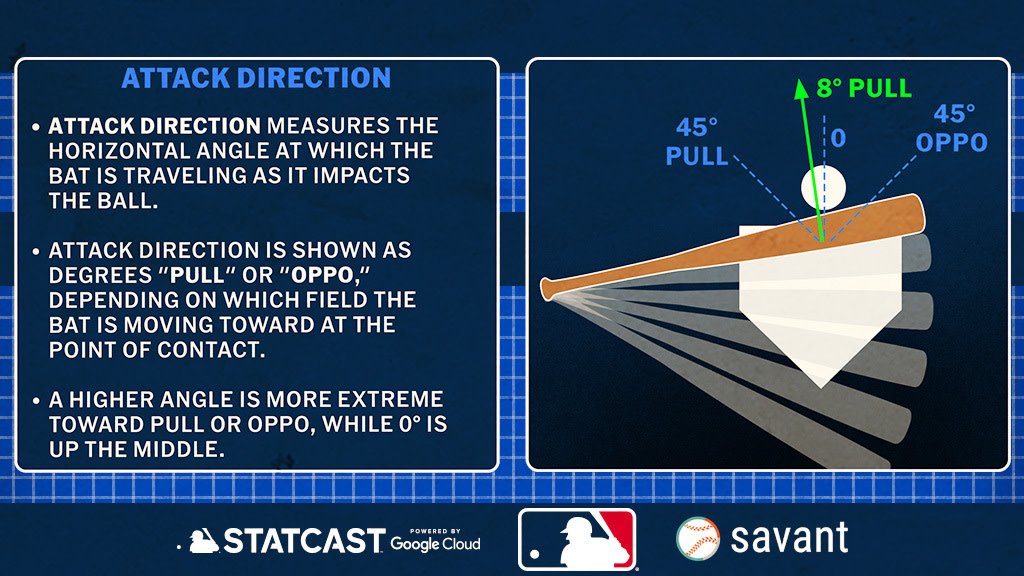
Using the framework of an “ideal” attack direction for sliders, modeling genius Stephen Sutton-Brown of Baseball Prospectus found that hitters were out in front more frequently when they believed the pitch was a fastball.
I can’t do anything as fancy as calculating pitch type probabilities, but I can use Alex’s Pitch Leaderboard to sort by attack direction on changeups. And what I find there, sitting all alone at the top, is Gaddis’ changeup. On average, hitters post an attack direction of 26 degrees to the pull side on the Gaddis changeup, by far the most pull-oriented approach in the sport.
| Pitcher | Attack Direction |
|---|---|
| Hunter Gaddis | -26.1° |
| Cole Ragans | -21.8° |
| Joey Cantillo | -21.7° |
| Mike Burrows | -19.1° |
| Connor Brogdon | -18.7° |
| Tanner Bibee | -18.3° |
| Michael Lorenzen | -18.2° |
| Alek Jacob | -18.2° |
| Angel Chivilli | -18.1° |
| Ryan Weathers | -18.1° |
This goes a long way toward explaining why changeups like Gaddis’ manage to thrive despite unremarkable movement and velocity characteristics. When changeups get hitters off balance, they get whiffs. The relationship between attack direction and whiff rate is pretty clear — when swings are more pull-oriented, whiff rates are higher:
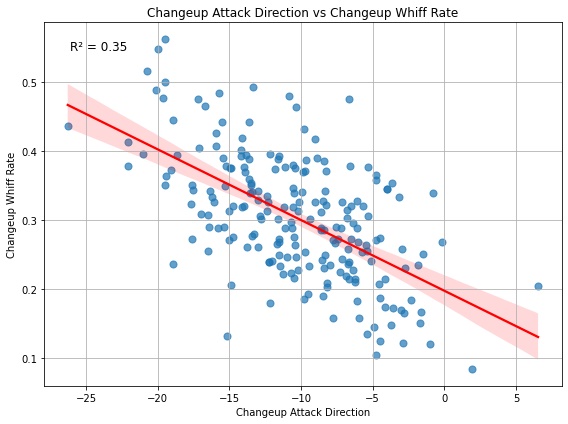
Changeup velocity, by comparison, has basically no relationship to whiff rate:
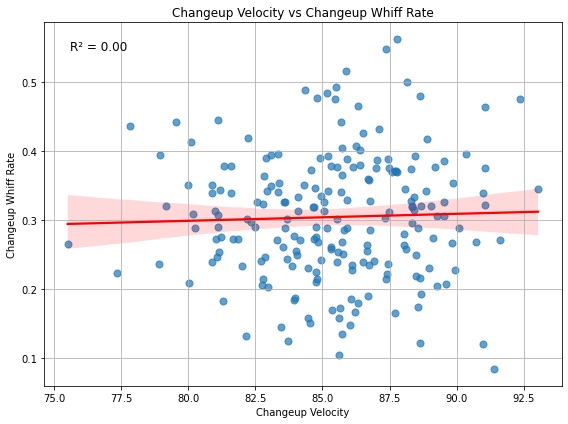
As a pitch type, changeups unsurprisingly have a pull-oriented attack direction. However, naturally, there are variations between pitchers in the average attack direction. Those variations, it turns out, are strongly associated with the differential between an individual pitcher’s fastball and changeup velocity:
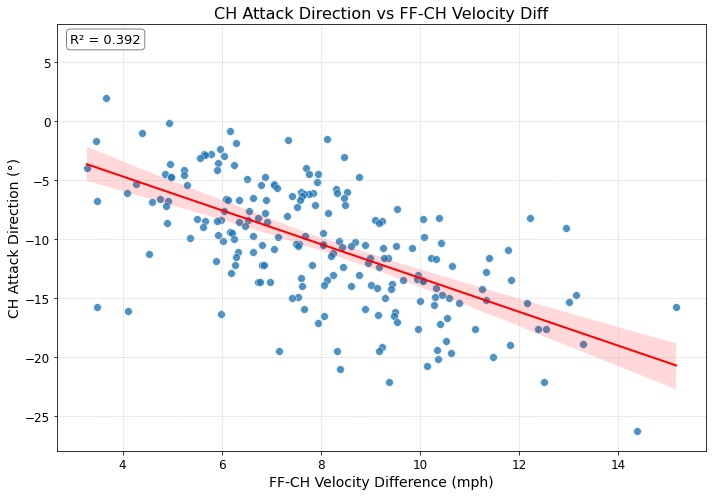
To summarize: Changeup whiffs are largely a function of getting hitters out in front, and getting hitters out in front is a function of maximizing the gap between fastball velocity and changeup velocity. No new ground broken there.
But velo differential isn’t the whole story. Bailey Ober’s fastball-changeup velocity differential is nothing remarkable, but hitters are still way out in front of that pitch. Velo differential explains much of the variation in attack direction, but not all of it.
What else causes hitters to flail at changeups? I had two theories. The first one: Similarity in the spin axes of these two pitches would lead to better outcomes. I thought a changeup that spins more like a fastball would be more difficult to read out of the hand. Swing and a miss — there was nothing there.
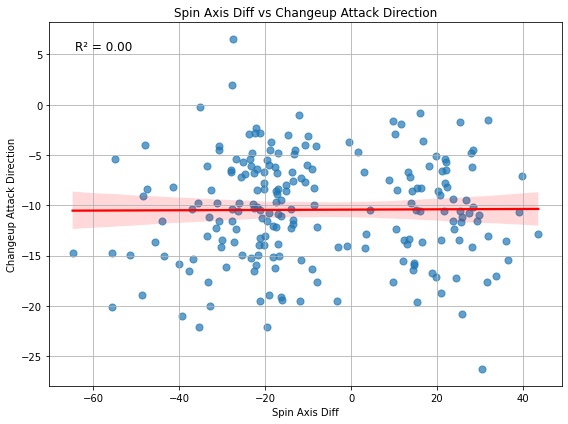
I also considered the similarity of arm angles between fastballs and changeups. Pitchers such as Erik Miller and Max Fried drop their arm angle when throwing changeups, in order to generate more vertical break. I assumed it would be easier for hitters to detect a changeup out of the hand from pitchers who drop their arm angle to throw them. But no dice there either.

There was one last variable I considered: Changeup arm speed. After a pitcher strikes someone out with a changeup, the color commentator will inevitably say something like, “The arm speed there was exactly like the fastball.” Slowing down the speed of the arm will certainly make a changeup slower, but hitters will likely detect mechanical alterations, thereby attenuating the increase in velocity differential. Do pitchers with similar arm speeds on both pitches see better results?
The answer must be yes — it’s hard to fully explain the Ragans changeup otherwise. But are announcers genuinely capable of watching a broadcast and assessing whether a pitcher’s changeup arm speed matches that of their fastball? Teams can probably add arm speed similarity to their models, but on the public side, that variable remains out of reach.
Changeups are weird. But these new data from Statcast, I believe, will demystify the pitch. Instead of using aggregated attack direction, which will inherently have a pitch location bias, someone could calculate a version of Alex’s miss distance for early/late swings. That miss distance could get even closer to identifying pitchers with the ability to disrupt timing. And the pitching analysis community will move closer to understanding what exactly makes certain changeups so good.
Michael Rosen is a transportation researcher and the author of pitchplots.substack.com. He can be found on Twitter at @bymichaelrosen.

Very interesting article, I would have thought for sure spin similarity would have contributed to attack direction.